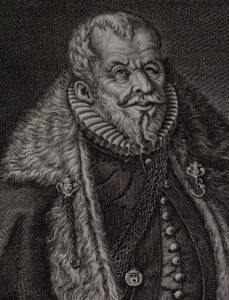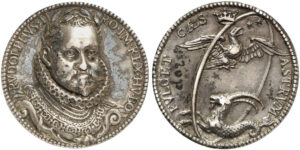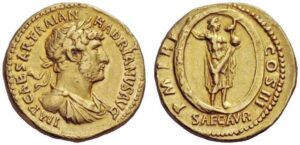In the first part we learned about Rudolf’s family situation and his disease. After the formative years at the Spanish court, Rudolf’s father prepared his son for becoming ruler, but then Maximilian died all of a sudden and Rudolf had to take his place.


The Emperor’s Coronation and Its Gnadenpfennigs
It was quite fortunate that Maximilian died while the powerful man of the empire gathered in Regensburg for the Imperial Diet. For cost-efficiency purposes, the coronation of the new emperor Rudolf was held immediately in Regensburg.
It is very likely that this gnadenpfennig made by the most important Habsburg medallist, Antonio Abondio, was struck in the context of the coronation. He had already worked for Rudolf’s predecessor and was to work for Rudolf’s successor, too, for every emperor needed these objects which are often mistaken for medals and which had the purpose of honouring deserving people around the emperor.
Gnadenpfennigs were given to foreign rulers and ambassadors, to members of the government, high-ranking military officers and to anyone whom a powerful man wanted to award a visible sign of his favour. They did not disappear in the drawers of a coin cabinet but were worn conspicuously over the clothes. Whoever received such an honour used the object to show the great favour he was in, and apart from that, such a gnadenpfennig with its necklace was of high financial value.
It’s obvious that these gifts were not only used by emperors and on the occasion of a coronation, however, every coronation was a time when the emperor had to be particularly generous. Therefore, it is very likely that this gnadenpfennig was struck in the context of the giving of gifts on the occasion of the emperor’s coronation even though there is no date engraved on the piece.
The depiction on the gnadenpfennig demonstrates that Rudolf had very high aspirations for his reign. It features an eagle with spread wings, flying towards a shining sun, in which a laurel wreath is hidden. As we can tell from contemporary collections of emblems, people back then believed that the eagle was the only bird that could look directly into the sun as the epitome of divine power without closing its eyes. This uniqueness made the eagle an ideal symbol for the emperor, who, in the depiction, earns the laurel wreath as a sign of victory by flying to the sun. The inscription “Für das öffentliche Wohl” (for the public good) described what the emperor wanted to fight for.



Rudolf’s ideas about his imperial office become even clearer when looking at his second coin. It features the Capricorn as the birth sign of the sovereign. Rudolf’s profound knowledge of antiquity and numismatics becomes evident here. He knew that already peace emperor Augustus had used this sign to refer to himself.
And there is a second symbol used by Rudolf in order to allude to Augustus. By inventing his great secular festival, Augustus signalled to the Roman public that a new era had begun. Paul van Vianen used this new, golden age as topic of the gnadenpfennig designed by him. It shows an oval representing the ouroboros, a symbol of eternity which was very popular among alchemists, too, and which depicts a serpent eating its own tail. We are familiar with the ouroboros from Roman coins as a symbol of the golden age, too. Rudolf repeatedly used this symbol.
The inscription “Es leuchtet des Kaisers Gestirn” (the emperor’s star is shining) comments the depiction, which features an eagle flying to the stars under the sign of Capricorn in order to herald a new era.
Great plans for the reign! And how did Rudolf II put them into practice?



A Lazy Emperor?
History books of the 19th century often describe Rudolf II as lazy and indecisive. This is contradicted by the fact that he summoned an Imperial Diet five times during the 34 years of his reign: in 1582, 1594, 1598, 1603 and 1608. The first two times he even attended the Diet himself. For comparison: Rudolf’s successor Matthias didn’t manage to convene a single Diet during the seven years of his reign.
Rudolf’s Imperial Diets were highly efficient. During these Diets, for example, the last generally recognised imperial police regulation was adopted as well as the Gregorian calendar, which is used worldwide today. For us numismatists it’s of course interesting to find out that the emperor regularly supervised the minting of coins in the empire and at least tried to intervene when the Reichspfennigmeister, the cash-keeper of the imperial exchequer, discovered that fractional coins deviated more and more from their specified fineness and weight.
In the age of emails, skype and a well-ordered bureaucratic system with an abundance of officials it’s difficult to imagine the tedious work an early modern ruler had to deal with. After all, he was involved in almost every decision regardless of its importance. This means that he had to read every incoming letter, think it through and answer it. Those who didn’t want to delegate their work to ministers soon had to face what we call a burn out today. The reason was that, in the second half of the 16th century, a ruler who was seriously concerned about the fate of his subjects had to deal with an incredible amount of problems. In theory, the religious denominations lived in peace, but there were obviously constant attempts from both sides to shift the balance in their favour.
As if it weren’t enough of a task to maintain religious peace, the emperor also pursued international politics. However, without success. He tried to get his favourite brother Ernest to the Polish throne. He put his brother Matthias in his place when Matthias made himself Governor-General of the Netherlands in a surprise coup. Conscious of the imperial claim to power, Rudolf also tried to reject the claims of the Pope and King Philip II of Spain in a diplomatic manner.
And then there was the great war against the Turks.

The Long Turkish War (1593-1606)
The defining event of Rudolf’s reign was the war against the Turks, which went down in history as the Long Turkish War and is unjustly almost forgotten today.
Everything started with minor border violations from both the Muslim and Christian side, which grew into larger expeditions. In 1592, the Ottomans conquered Bihac, an important fortress under Habsburg control. This overstepped the mark, the war had begun. Rudolf had to do something if he didn’t want to lose a large part of his eastern territory.
But Rudolf had a problem. He was emperor of the Holy Roman Empire, but the countries where Turkish attacks took place weren’t part of the empire. In theory, he therefore had to face the task of defending them alone. In practice, however, the emperor’s coffers were empty. Rudolf hadn’t enough money to finance an effective defence of his territories. Alone, he could not stand up to the Turks. There was only one thing left to do: he had to explain to the princes of the empire why they should fund the war against the Turks.
For us today, it seems to be obvious that “defeating” the Turks was the business of all Christians in the empire. We no longer recognize the great achievement of Rudolf and his ambassadors. Rudolf convinced the Imperial Estates – the Protestant ones, too! – to financially support the Turkish war as if the empire itself were under attack.
The empire’s central government made use of every single form of modern media to disseminate its opinion about the Turkish war. There was a huge number of single-leaf prints reporting on what happened at the front. Additionally, there were other media typed such as – obviously – medals.

Let’s have a look at an example: a cast medal, which was probably produced in various metal versions with the purpose of sending it to European courts in order to put forward Rudolf’s views on the matter. The obverse features Rudolf as emperor riding a horse. The depiction is reminiscent of the bronze statue of Marcus Aurelius, with whom any somehow educated nobleman was familiar at the time. Victoria flies into the image from the left in order to crown the sceptre and thus the reign of Rudolf. Once again, we see the circle of the ouroboros as the symbol of the new century. To rule this age victoriously, the emperor defeated the fury of war. It lies on the ground in the shape of an old woman enabling Rudolf’s horse to step over her.
However, the reverse is much more interesting. It shows Rudolf sitting as ruler in the circle of the electors. At first glance, this has nothing to do with the Turkish war. Only if you know that the Imperial Diet provided the necessary means for this conflict, you’ll understand why Rudolf portrays himself here as ruler of the Holy Roman Empire. The image does not only refer to the Turkish war indirectly, instead, the issue is addressed in detail: A bound Turk lies at Rudolf’s feet as a symbol of victory. On the emperor’s right (the observer’s left) stands a skimpily clad woman with a laurel branch crowning the emperor with the victor’s wreath. It’s Victoria, the personification of victory. On Rudolf’s left (the observer’s right) Bellona, the goddess of war, wields her sword. She holds a palm branch, the symbol of victory in her hand.
Unfortunately, it didn’t really work out with the victory. The funding was nothing like enough and had to be bought with major concessions to the Protestant Imperial Estates. Thus, it’s no surprise that Rudolf had to make it seem as if conquering Raab had been the central event of the war.
In the 3rd and last part, you can read how the conquest of Raab found its way into medal art and learn about the importance of art and collecting in Rudolf’s life.
Here you can find all episodes of this three-part article.






